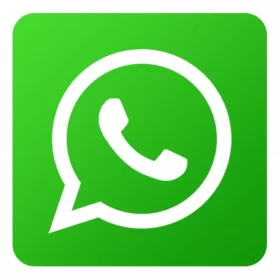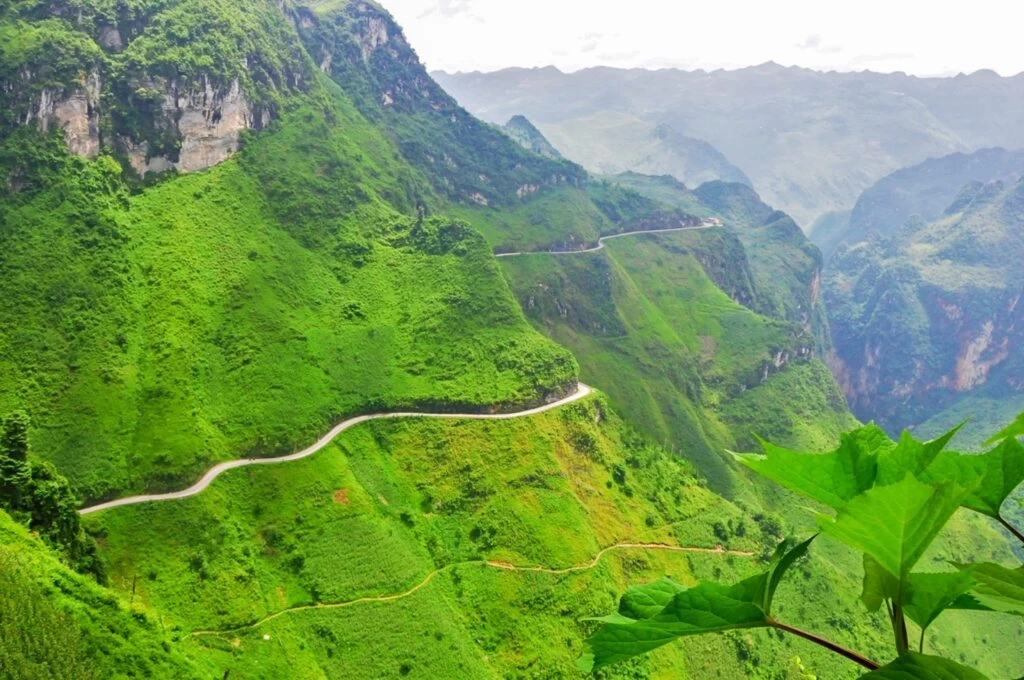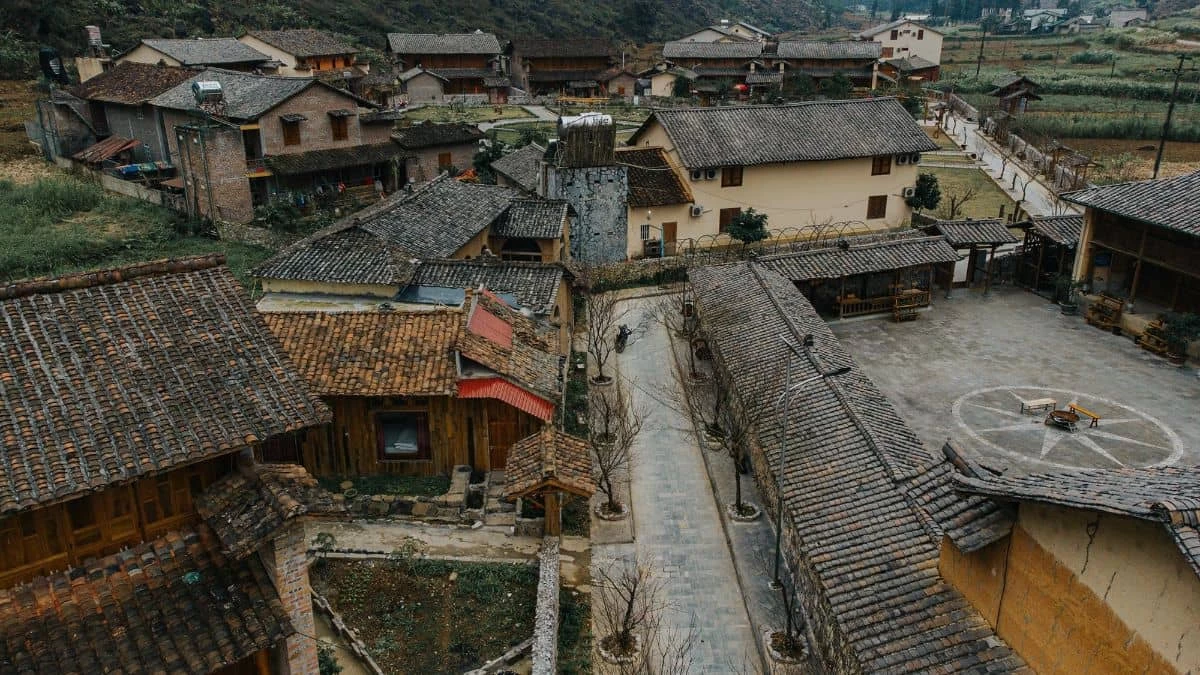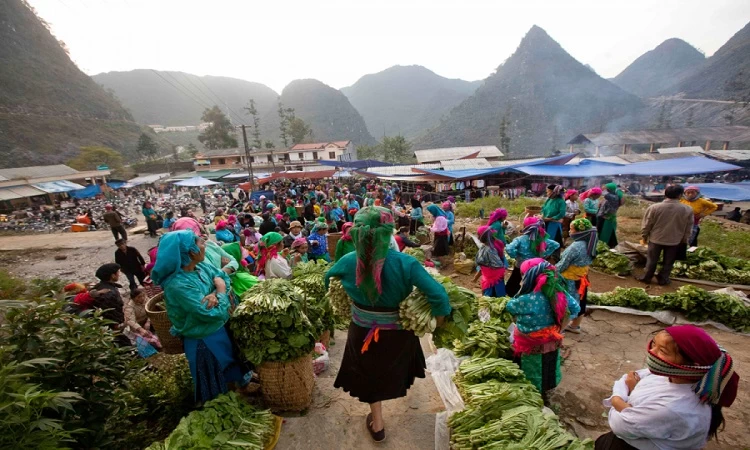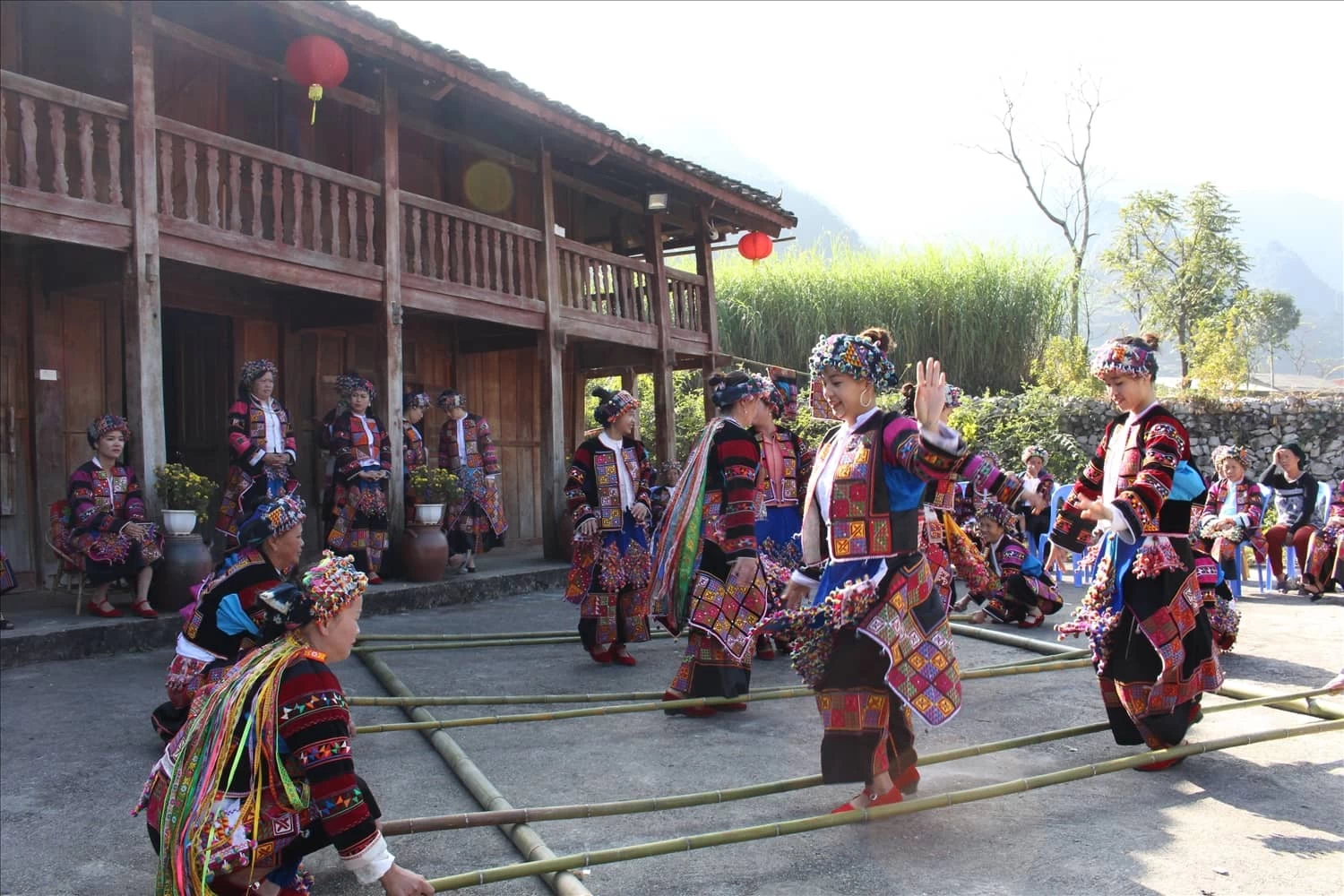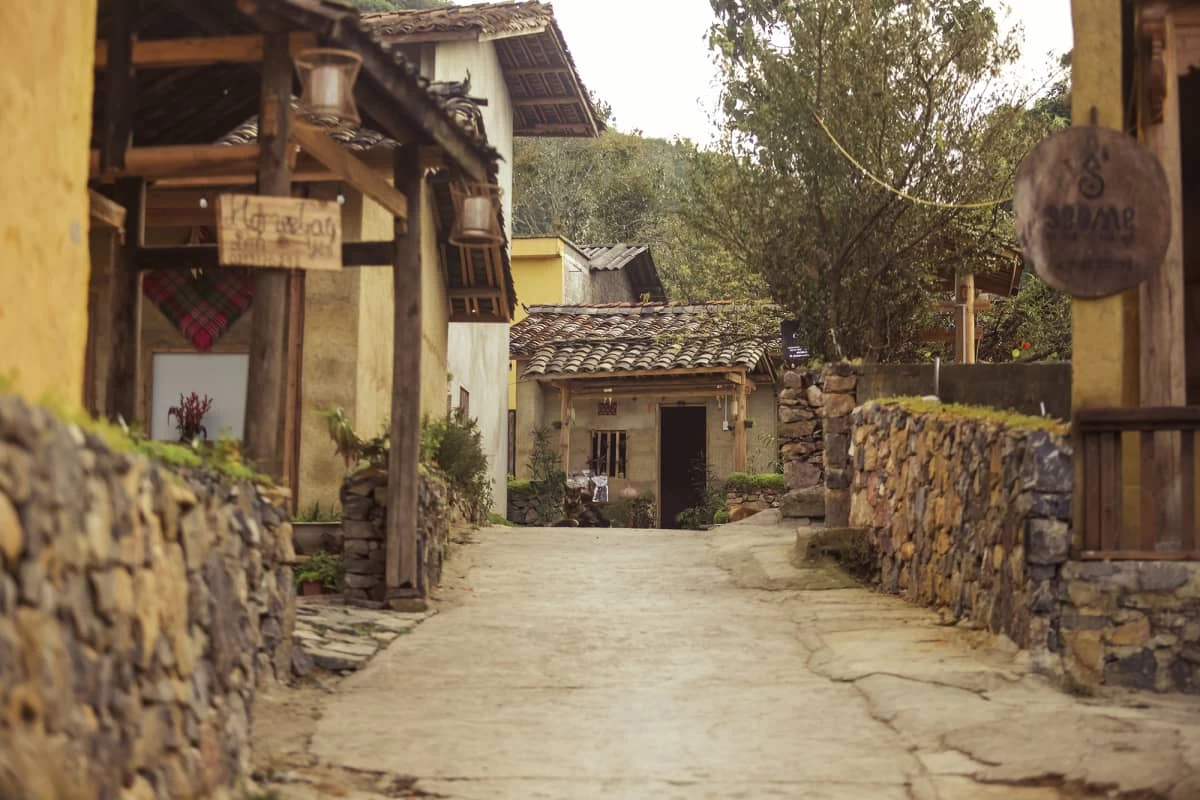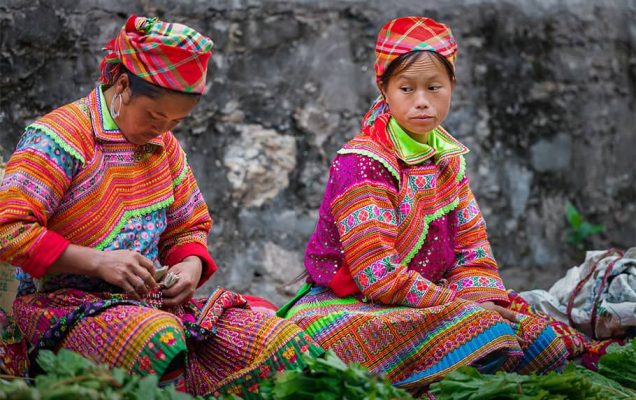
Ethnic Groups in Ha Giang
The ethnic groups in Ha Giang contribute significantly to the vibrant culture, offering visitors a unique glimpse into the traditional ways of life that have been preserved for generations. From colorful festivals to intricate traditional clothing and ancient customs, the ethnic groups in Ha Giang provide a fascinating and enriching cultural experience for all who visit. Let’s explore with Ula Travel the 5 main ethnic groups in Ha Giang along with their cultural beauty.
I. What Makes Ethnic Groups in Ha Giang One of a Kind?
Ha Giang, located in the northernmost region of Vietnam, is renowned for its breathtaking landscapes, including towering limestone mountains, deep valleys, and winding rivers. This province is a treasure trove of natural beauty and cultural richness, making it a unique destination for travelers seeking both adventure and cultural immersion.
One of Ha Giang’s most distinctive features is its diverse ethnic composition. The province is home to a vibrant tapestry of ethnic groups, each with its own unique customs, traditions, and way of life. This diversity is not only reflected in the daily lives of the people but also in their festivals, traditional clothing, and unique architectural styles.
The major ethnic groups in Ha Giang include the H’Mong, Dao, Tay, Nung, Lo Lo, and several others. Each group contributes to the province’s rich cultural mosaic, creating a dynamic and colorful cultural landscape.
The ethnic groups in Ha Giang play a crucial role in preserving and enriching the cultural heritage of the region. Their traditional practices, folklore, music, and art form the backbone of Ha Giang’s cultural identity. Visitors to Ha Giang have the opportunity to experience this rich cultural heritage firsthand by participating in local festivals, exploring ethnic villages, and engaging with the local communities.
II. The 5 Main Ethnic Groups in Ha Giang
Compared to other parts of Vietnam, Ha Giang‘s cultural diversity makes writing about its ethnic groups much more challenging. We can, however, review the five signature groups:
1. H’mong People
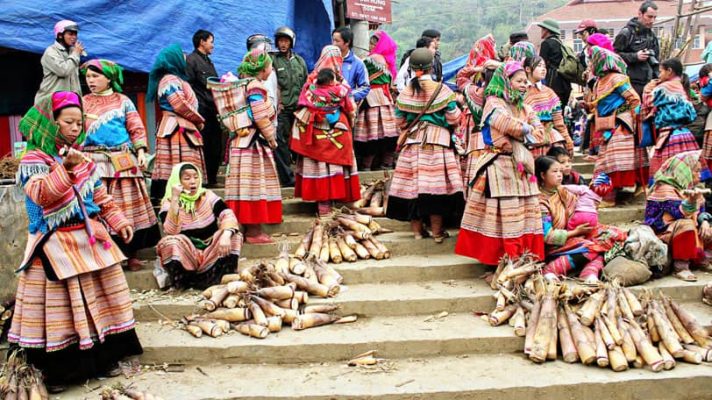
H’mong people
The H’mong people are an indigenous ethnic group in Vietnam, whose ancestors first came from China some 300 years ago. The H’mong, who make up 32% of the population of Ha Giang, are the largest ethnic group in the province.
Geographical distribution:
The H’mong ethnic group primarily resides in the two western districts, Hoang Su Phi and Xin Man, as well as the northern districts of Quan Ba, Yen Minh, Dong Van, and Meo Vac.
Main features:
- Housing: timber homes with thatched roofs, clay walls, or homes raised on stilts. Usually, there are two lean-tos, three compartments, and two to three doors per compartment. The central chamber of the house is designated for an altar.
- Traditional costumes: H’mong men wear black clothing, short blouses, long pants, and a headscarf. Women grow flax and weave linen. They wear white skirts with V-neck collars and embroidered patterns on the sleeves. They shave a portion of their hair and wrap wide-brimmed scarves around their heads.
- Cuisine: Typical dishes of H’mong people include “men men” (maize cake), cakes made with corn flour, rice, corn wine, and rice wine, and “thang co” (a hot pot with a mixture of horse or goat meat and internal organs).
- Festivals: One month ahead of the Lunar New Year, the H’mong people began celebrating the traditional New Year at the start of the 12th lunar month. Every year on September 2, the H’mong people commemorate Independence Day in other regions as well.
Do not miss: Ha Giang Cuisine
2. Lo Lo People
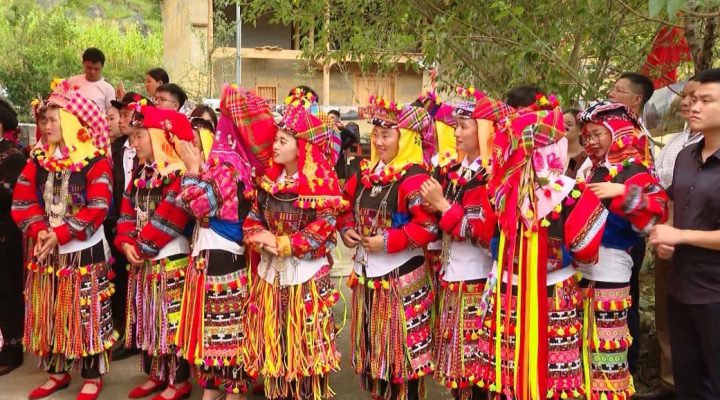
Lo Lo people
This Tibeto-Burmese linguistic group derives its name from their adoration of the tiger; in their dialect, the word “Lo” means “tiger.” The Lo Lo people of Vietnam originated from the Di people in China. After migrating to Vietnam, they settled in what is now the Dong Van district in the province of Ha Giang. Though they were thought to be the first people to arrive in these remote locations, currently there are just approximately 1400 Lo Lo living in Ha Giang.
Geographical distribution:
The Lo Lo now live in Meo Vac and Dong Van, Ha Giang. The highland districts in the border provinces of Cao Bang and Lai Chau are also home to practically all Lo Lo people.
Main features:
- Housing: Traditional houses include three different types of houses, such as houses on the ground, houses on stilts, and half-stilt-half-earth houses.
- Traditional costumes—scarves, tops, skirts, leggings, aprons, belts, and shoes—are examples of women’s clothing. Lo Lo ladies wear headscarves frequently. Ha Giang‘s Lo Lo ladies weave scarves that are either black or indigo, with a variety of colors and textures at the ends and in the center of each scarf. Men dress in all black, with an indigo scarf and a four-piece shirt buttoned under the right armpit.
- Cuisine: The Lo Lo people eat rice, maize rice, sticky rice, men men (steamed minced corn), and sticky rice in a bamboo tube as part of their regular diet. The ethnic group cooks a variety of various foods during the holidays, including roast beef, banh troi (floating rice cake), banh ran (deep-fried glutinous rice ball), and banh chung (square glutinous rice cake). The Lo Lo people of Meo Vac make banh chung with sticky grain during Tet.
- Festivals: Like the Chinese and Vietnamese, the Lo Lo people celebrate the Lunar New Year. They celebrate New Rice, the Mid-Year Festival, the July Full Moon, and other customs.
Are you looking for: All Tours To Ha Giang
3. Tay People
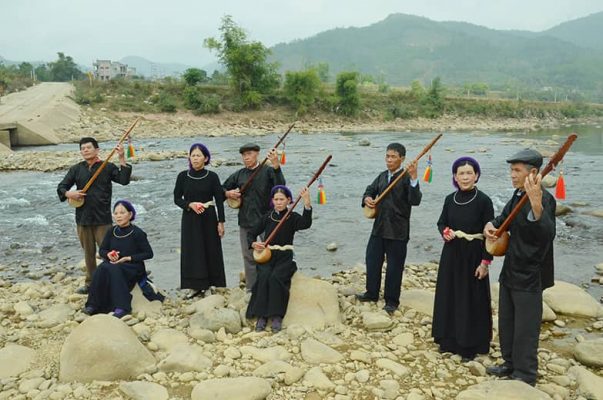
Tay people
Similar to Lo Lo, the Tay people arrived in Ha Giang at a relatively young age and were among the first inhabitants of prehistoric Ha Giang. They are currently regarded as Vietnam’s largest ethnic group. More than 23% of Ha Giang‘s population are Tay.
Geographical distribution:
The Tay are plains and valley people that typically reside close to a mountain’s base.
Main features:
- Housing: The three main forms of Tay traditional buildings are: defensive houses, half-ground and half-stilt houses, and houses on stilts. There is a stone dog at the gate of every The Tay people think that the stone dog will assist the owners in maintaining the home and warding off misfortune.
- Traditional costumes: Indigo-dyed handwoven cotton garments are worn by both sexes. Women dress in knee- or waist-length, high-collared shirts with buttons on the right side. Their pants have a broad belt and large legs. Tay women love to accessorize with jewelry, especially bracelets and silver necklaces. Men and women dress pretty much the same.
- Cuisine: Plain rice is the primary ingredient used by this ethnic group in their daily cooking. The Tay people create a variety of sticky rice dishes and cakes, including porridge, lam rice, vermicelli, and nuggets, using both plain and glutinous rice in addition to the regular rice they eat. The Tay ethnic group is known for its specialty, ant egg cake, which is created primarily from the eggs of black ants that establish their nests on tree branches. The eggs are stir-fried with lard, salt, palanquin, or scallions.
4. Nung People
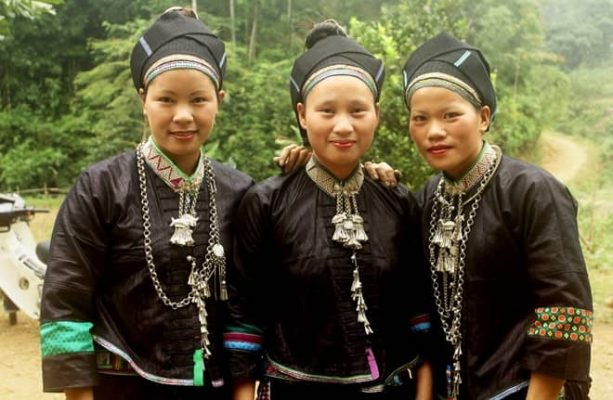
Nung people
The Nung are an ethnic group that speaks Central Tai and is mostly found in Ha Giang and southwest Guangxi. Thổ, which means autochthonous, is the term used by the Nùng to refer to themselves at times. As Tày-Nùng, their ethnonym is frequently mixed with the Tay’s.
Geographical distribution:
Nung people are mainly distributed in Quan Ba district; they live in valleys near rivers, streams, or hills.
Main features:
- Housing: The traditional Nung home is a three-story stilt home with a tubular tile roof. Livestock, poultry, and farming equipment are kept on the ground floor; the primary living area is located on the second floor; and food and other supplies are kept in storage on the third floor. A typical house has a drying area in front of it. The Nung people construct “trinh tuong,” or earthen dwellings, in some locations. Stoves are used in Nung homes not only for cooking but also for warmth, particularly in the chilly winter months.
- Traditional costumes: The Nung ladies wear five-panel robes with buttons under the right armpit, mostly in shades of blue. Men wear collared shirts that are open at the breasts and belly, with four uncovered pockets and a row of fabric buttons.
- Cuisine: The primary diet of the Nung ethnic group is rice. They also relish special meals served during significant holidays. The Nung people butcher capons and produce lengthy banh chung for the Lunar New Year festivity. The Nung people typically prepare rice and young mugwort leaf treats at the conclusion of the first lunar month. On weddings and birthdays, roasted pigs filled with clausena leaves are a must.
5. Dao People
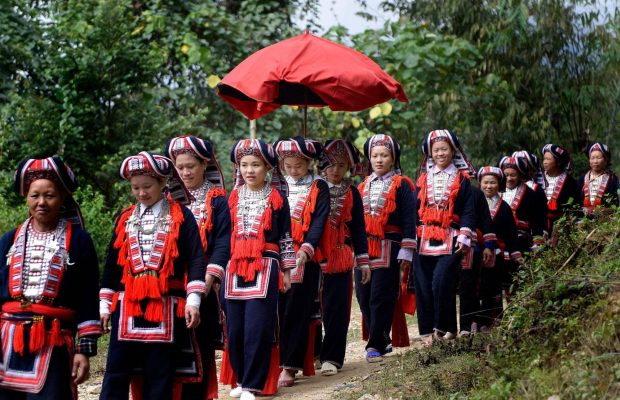
Dao people
The Dao people have their origins in China, and their migration to Vietnam began in the 12th and 13th centuries and lasted until the 20th century.
Geographical distribution:
The Dao ethnic group mostly lives in Hoang Su Phi, a district located in the west of Ha Giang province. Households here mainly live on hillsides and upland fields with not too steep slopes and are quite separate from each other.
Main features:
- Housing: The Dao people live in different types of houses: ground-level houses, stilt houses, and half-stilt houses.
- Costumes: Previously, Dao men wore long hair, with a bun behind the nape of the neck or a long tuft at the top, with the surrounding hair shaved off. Different Dao sub-groups have different ways to wear headscarves. There are two types of dresses for Dao women: long and short. Their clothes are very colorful and decorated with various patterns, including the swastika, pine trees, birds, humans, animals, and leaves.
- Food: The Dao people’s main staple is rice, but some areas consume corn more than rice. Their favorite dishes include boiled meat, dried meat, marinated meat, and sour bamboo shoot soup.
- Festivals: The Dao people celebrate the New Year in the first month and make offerings to their ancestors in the first seven and twelfth months. Other ceremonies of the Dao people include the rite of passage, weddings, funerals, prayer for health, and making offerings to gods.
III. Experience the Culture of the Ha Giang Ethnic Groups
1. Visit Ethnic Markets
The markets in Ha Giang province are mostly used by ethnic minorities to purchase weekly items and trade locally produced goods. They sell a wide range of items, such as household products, jewelry, and farm equipment. With traditional closings from ethnic minorities like the H’mong, Dao, and Giay, these marketplaces also function as social hubs. In Ha Giang, almost every village has its own market; the province as a whole has around 50 marketplaces.
Here are some ethnic markets to which you should come:
a. Khau Vai Love Market
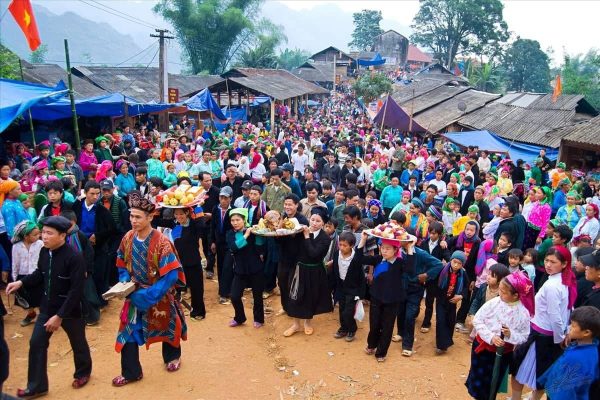
Khau Vai Love Market
Khau Vai Love Market is held every 27th day of the third lunar month in Khau Vai Commune, Meo Vac district, about 180 kilometers away from the city center of Ha Giang. The Khau Vai Love Market festival originated from an ancient story about forbidden love.
There are two sections to the festival: the festive and the ceremonial. The inhabitants of Khau Vai offer prayers during the ceremonial portion to honor their ancestors and honor the love between couples. During the celebration, guests can partake in a variety of amazing activities to learn more about the exquisite culture, enjoy Ha Giang’s delicacies, and make lifelong memories.
b. Meo Vac Market
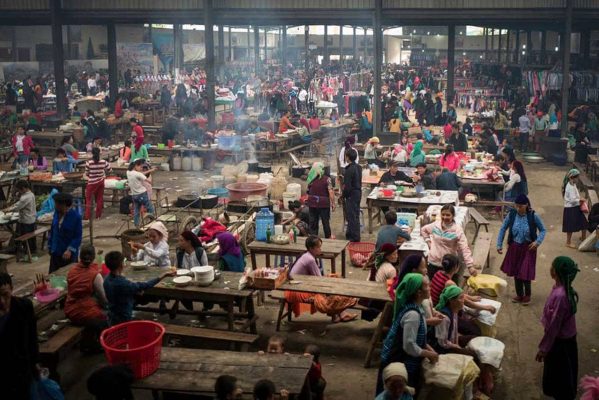
Meo Vac Sunday market
Meo Vac market starts quite early, at 5 a.m. every Sunday, in the indoor market area of Meo Vac, Ha Giang. The market stands out above all for its authenticity. The Sunday market is for locals from around the world to purchase and exchange goods, so instead of tourist-oriented souvenirs, you will find daily products for locals’ daily needs.
Start your journey now: Ha Giang Tour Package 5D4N
2. Visit Ancient Architecture
The ethnic groups of Ha Giang construct homes that are tailored to their cultural requirements as well as the severe mountain climate and topography. Therefore, while visiting these ancient structures, you can see certain variances in their architecture. We highly recommend you visit this location to admire the beauty of the Ha Giang ethnic groups’ architecture.
a. The Mansion of Vuong Family
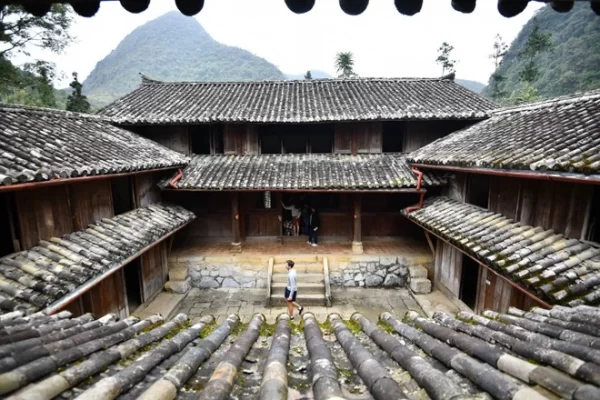
The Mansion of Vuong Family
- Address: Sa Phin Valley, Dong Van district, Ha Giang
- Price: 20.000 VND
- About this place: The Vuong family mansion, located on the Dong Van karst plateau, is a masterpiece of Mong architecture and was recognized as a national architectural and artistic relic in 1993. The Mong people live there. The H’mong Royal Palace is the historic mansion of King Vuong Chinh Duc, who was the only H’mong king acknowledged by the Ha Giang ethnic group at the start of the 1900s.
b. Dong Van Ancient Town
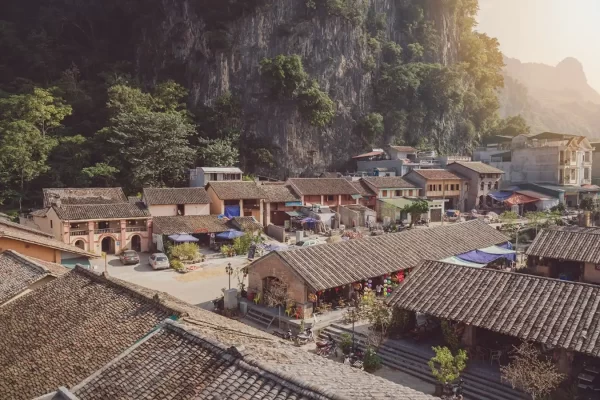
Dong Van Ancient Town
- Address: Dong Van town, Dong Van district, Ha Giang
- Price: 50.000 VND
- About the Place: Ha Giang‘s historic dwellings are constructed in the two-story tube house style, which is unique to the Northeast border region, and have yin-yang tiled roofs. When you visit Dong Van early in the morning, the view of the historic town covered in mist will undoubtedly make your heart skip a beat. In the meantime, Dong Van appears to “change into a new outfit” when night falls because of the lanterns. Come here at dawn or dusk, and we promise to provide you with gorgeous photo ops.
More details: Ha Giang to Cao Bang Tour
3. Attend Festive Festivals
Festivals are a great opportunity to learn about Ha Giang’s ethnic groups cultures and see them come alive. You’ll see traditional clothing, music, dance, and food, all of which create an unforgetable memory for you. Moreover, this is also a chance for you to support the local community. Try to participate in festivals such as the Buckwheat Flower Festival and the Long Tong Festival.

The Buckwheat Flower Festival
One of the most famous festivals in Ha Giang is probably the Buckwheat Flower Festival. Held in October every year, the Buckwheat Flower Festival is celebrated to honor the beauty of buckwheat flowers, the symbol of Ha Giang cultural heritage values, as well as promote tourism and the culture of ethnic minorities in the Northeast.
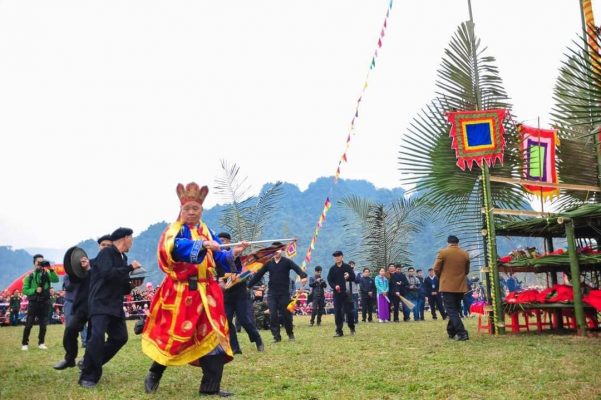
The Long Tong Festival
Long Tong is another festival that you should not miss in the early spring. The Long Tong Festival is held on the eighth day of the first lunar month in Quang Binh district, Ha Giang province. The festival is a cultural and belief-based practice of the Tay. The festival was an ancient agricultural ritual meant to signal the beginning of a new agricultural season. It is an opportunity for the Tay people to show their gratitude to the Heaven God, the genies, and their ancestors.
4. Overnight in an Ethnic Homestay
Skip the ordinary hotel and opt for an unforgettable experience at a Ha Giang ethnic homestay. Imagine waking up in a traditional stilted house or a charming earthen dwelling, surrounded by breathtaking mountains. Immerse yourself in the rich culture of ethnic minorities.
Learn more about: Ha Giang Accommodation
a. Du Gia Homestay
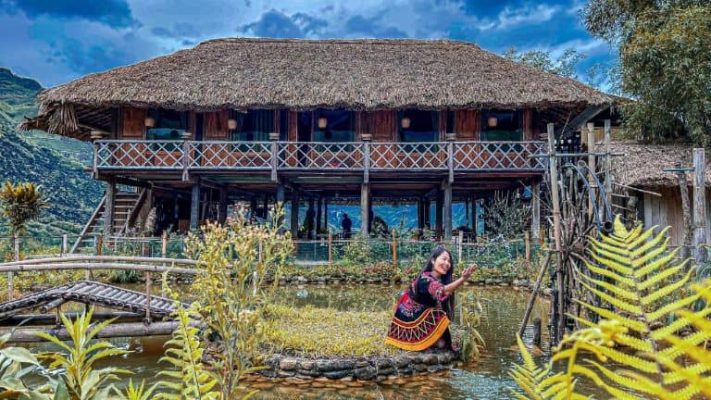
Du Gia Homestay
- Address: 195B Du Gia, Yen Minh, Ha Giang
- Price: 200.000 VND–300.000 VND
Located in Cac Village, Du Gia Homestay welcomes guests in a comfortable atmosphere with a restaurant, free motorbikes, a shared lounge, a garden, and BBQ facilities. This destination receives many positive reviews from visitors.
b. Meo Vac Clay House
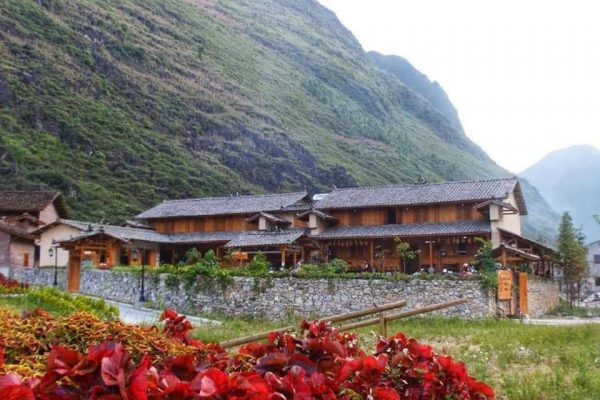
Meo Vac Clay House
- Address: Mong cultural village, Pa Vi Ha, Meo Vac, Ha Giang
- Price: 700.000 VND–850.000 VND
Located in a convenient central location, this homestay helps visitors easily move to famous tourist destinations. With its modern and unique architecture, Meo Vac Clay House gives visitors a special experience. The space design from outside to inside combines sophistication between modernity and tradition of the Northwest mountainous people.
See more: Ha Giang Travel Tips

